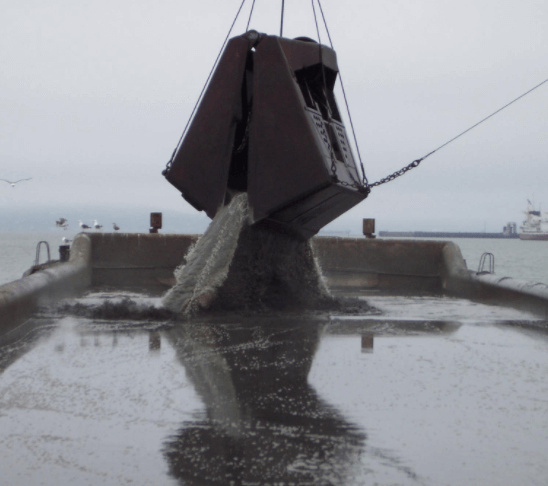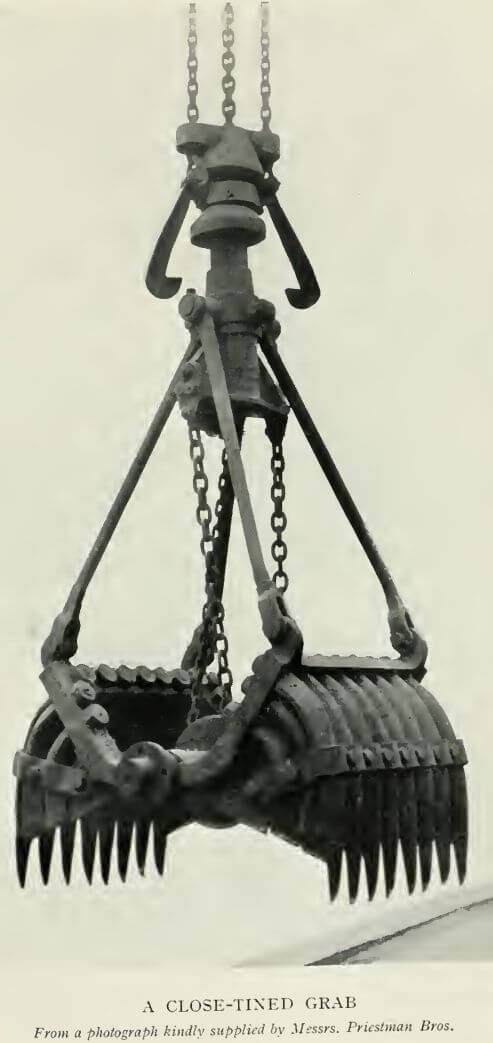 The grab, or “ clamshell ” type of dredge, consists of a self-filling and discharging scoop or bucket, with the necessary engine power for working this from a crane. Well-known makers of this form of dredge are Messrs. Rose, Downs, & Thompson, Limited (see illustration), and Messrs. Priestman Bros. Both firms recommend, for this purpose, the double-chain grab. A one-ton capacity Kingston dredge, with 7-in. diameter cylinder, 10½-in. stroke engine, 50 lbs. working pressure, and surplus boiler powder to drive a centrifugal pump, trommel, and winches would cost about £600. The weight of such a grab, with engine and boiler, would be about 17 tons; platform dimensions, 5 ft. by 6 ft. The vertical lift from deck board, for stability, should not be over 20 ft., or, deducting the length of the grab, say, 14 ft. effective. As the working of the grab causes considerable oscillation of the barge, it is well to place the gold-saving tables, sluices, &c., on a separate barge. It is, therefore, probable that a complete dredging plant, capable of dealing with 40—50 tons per hour at a moderate depth would cost about £2,250, pontoons included, but built locally from cheap timber. Another form of grab is that of Hone, manufactured by the Thames Ironworks, Limited, London. It is of the single-chain type; it does not require to be dropped with force, but when lowered gently will sink itself as soon as power is put on, and in ordinary soft material it fills up to its full capacity. It is also provided with a hydraulic cylinder break, by which the discharge is made gradual. The cost is rather high, a grab alone, of 1½ cubic yards capacity, costing £120. For dredging in ground where there are obstructions the double-chain grab has the advantage that the grip of the grab on any obstruction can be immediately released, whereas with the Hone grab it might be necessary to send down a diver for that purpose.
The grab, or “ clamshell ” type of dredge, consists of a self-filling and discharging scoop or bucket, with the necessary engine power for working this from a crane. Well-known makers of this form of dredge are Messrs. Rose, Downs, & Thompson, Limited (see illustration), and Messrs. Priestman Bros. Both firms recommend, for this purpose, the double-chain grab. A one-ton capacity Kingston dredge, with 7-in. diameter cylinder, 10½-in. stroke engine, 50 lbs. working pressure, and surplus boiler powder to drive a centrifugal pump, trommel, and winches would cost about £600. The weight of such a grab, with engine and boiler, would be about 17 tons; platform dimensions, 5 ft. by 6 ft. The vertical lift from deck board, for stability, should not be over 20 ft., or, deducting the length of the grab, say, 14 ft. effective. As the working of the grab causes considerable oscillation of the barge, it is well to place the gold-saving tables, sluices, &c., on a separate barge. It is, therefore, probable that a complete dredging plant, capable of dealing with 40—50 tons per hour at a moderate depth would cost about £2,250, pontoons included, but built locally from cheap timber. Another form of grab is that of Hone, manufactured by the Thames Ironworks, Limited, London. It is of the single-chain type; it does not require to be dropped with force, but when lowered gently will sink itself as soon as power is put on, and in ordinary soft material it fills up to its full capacity. It is also provided with a hydraulic cylinder break, by which the discharge is made gradual. The cost is rather high, a grab alone, of 1½ cubic yards capacity, costing £120. For dredging in ground where there are obstructions the double-chain grab has the advantage that the grip of the grab on any obstruction can be immediately released, whereas with the Hone grab it might be necessary to send down a diver for that purpose.
In certain localities, the grab dredge has advantages over the bucket or ladder type. Amongst these are the following: It goes into small compass, can be easily moved about, can be worked in confined places where a ladder dredger would be useless; the wear and tear is small; it will work to varying depths without requiring adjustment; one man can work the crane, and, when not required for dredging, the machines, by detaching the grab, can be used as an ordinary lifting crane, which is often a great convenience.

“ Grabs ” with a capacity of from 3 cwt. to 40 cwt., or more, are supplied by the makers, and the type of grab used depends upon the nature of the material to be lifted; but in sending abroad it is very usual to supply one of each of the types usually illustrated in trade catalogues.
Notwithstanding the advantages mentioned, the grab dredge is obviously not the most efficient machine for gold-dredging, for several reasons, one being that the grab cannot be made watertight, consequently some of the gold is likely to be carried away by the out-draining water, while the grab is being elevated. Again, it is not easy, even with the best arrangement of hopper, to wash and properly treat the material which is dumped into it intermittently in large quantities. Further, grab dredges are unsteady in work, and, therefore, unsuited for the proper action of sluices and gold-saving tables. Finally, the proper vertical fall of the grab is interfered with by a rapid current, say of from five to six knots and upwards per hour. Nevertheless, this type of machine has often done good work. At Greymouth, New Zealand, the only dredge that, up to 1890, had been made to pay for working was a combination of a pump and a Priestman grab. The former raised the sand and small shingle, and the latter the coarse gravel and boulders. Mr. Franklin White, writing on the use of these dredges for saving gold, says:
“ The Priestman dredger which, on my recommendation, was supplied to the French (Nechi) Gold Mining Company for dredging for gold in South America, worked to my entire satisfaction, and I know of no other system of dredge so adapted to the general requirements of such work.
“ The bed-rock in the River Nechi was reached at a depth of 15 ft. to 16 ft. from the present bed of the river; the bucket excavated its way very well through sand, shingle, pipeclay, &c. It appears that a very small proportion of the gold contained in the deposit escapes the grab. Many pieces of tree trunks are found bedded in the gravel beds, and these impediments, so troublesome to a ladder dredger, are managed easily by these machines. The fact that grab dredgers are able to penetrate the beds to any ordinary depth, without having to be stopped for adjustment, is a point which certainly merits attention. I believe this machine has only to become more widely known amongst miners to be very largely used, as there are many rivers which are too big to be easily diverted from their channels, and yet contain valuable deposits easily to be obtained by a proper class of dredging machine.”
The quantity of deposit raised depends very much, of course, on the depth from which it is to be lifted, and on the nature of the material; but, supposing the grab in use to hold 20 cwts. of deposit and to be working in 20 ft. of water, the output in ordinary material should be about 40 tons per hour, estimating the dredger to make 50 lifts per hour, or, say, 500 tons per day of 10 working hours. The consumption of coal on this sized machine would be about 90 lbs. per hour, or, say, 2 lbs. of coal per ton of deposit lifted.
Where coal is not easily available, special fire-boxes are supplied to burn wood, if this is obtainable. When working in very stiff clay or hard gravel, the output would probably not exceed two-thirds of the above, or in some cases possibly not more than one-half, though the coal consumption would be practically the same (90 lbs. per hour).
The above remarks specially refer to a grab crane fixed on a barge, but the reader will readily understand that these machines are equally of service on shore, the grabs being worked from locomotive travelling cranes, instead of from fixed cranes; all cranes, however, which are required for constantly working grabs, should be made specially strong to stand the more or less constant strain that is put upon them.
Messrs. Rose, Downs, & Thompson, Limited, of Hull and London, are the sole manufacturers and patentees of the Kingston Double-chain Grab Dredge, of which an illustration is given.
